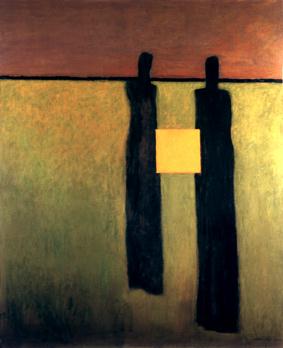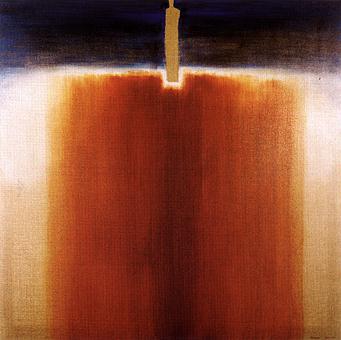Itzu Rimmer
The Art of ltzu Rimmer as Visual Contemplation on Transcendence
ltzu Rimmer is an Israeli artist. This statement refers to
his nationality, place of residence, and cultural background,
but it also expresses an essential characteristic of his work.
His paintings reflect the complexity and the tensions that are
prominent in current Israeli existence. Some of these conflicts
can also be found at other places, but here they are particularly
conspicuous. The abstract conflicts between orient and occident,
between the religious and the secular, between the traditions
of the past and the future with its blurring of cultural and
ethnic identities, between the materialistic and the spiritual,
take in Israel the form of actual, concrete daily confrontations.
However, the relevance of his art is not confined to Israel.
The personal observation and the local perspective can provide
novel insights on some of the dilemmas and tensions that are
common to people around the world. This is the basis for the
universal value of ltzu Rimmer's work, in spite of its clear
and explicit local connections.

Twillight, oil on canvas
1994
162 x 130
ltzu Rimmer is a non-religious Israeli, yet he is a religious
painter. He deals with mysticism and religious experiences from
a secular point of view. His work is a very personal attempt
to come to terms with basic religious feelings. Here a person
at the end of the 20th century considers the mystical experience
in its purest form, without the intervention of religious institutions
and outside any establishment. These paintings hold a unique
place, especially now when it seems that religious motives in
art have become obsolete, and in particular in Israel, where
the relation of the secular majority towards religious issues
is very complex.
The technique and style of ltzu Rimmer's work is strongly connected
to the artistic training he received at the Bezalel Academy of
Art of the mid-seventies. It was at that time dominated by the
inexorable spirit of conceptual art and painting seemed outdated.
He insisted on painting and maintained his characteristic way
of doing art ever since, while exploring various styles and topics.
Yet the conceptual basis is still prominent in his work. His
paintings combine emotional expression with the contemplative
examination of a phenomenon. They express feelings that arise
out of the intellectual confrontation with fundamental questions,
and do not refrain of dealing with ideas and thoughts. ltzu Rimmer's
work is characterized by a commitment to simplicity. He depicts
details and forms sparingly. Especially prominent is the use
of empty space and empty canvas. The artist's decision not to
touch the canvas is often more important than his painting on
it, and expresses a strong commitment to an idea.
 Creation of light, oil on canvas
Creation of light, oil on canvas
1996
89 x110
The use of empty canvas to depict forms makes it impossible
to alter things - once covered with paint, the canvas becomes
irrervocably marked. This subtle technical aspect provides some
indication of the great amount of thought that was put into each
move in the painting. Painting for ltzu Rimmer is a calculated
act that combines spontaneity with strict self-discipline. ltzu
Rimmer is strongly connected to the desert and is fascinated
by its aesthetics and mystery. Its colors dominate all his paintings.
The wide expanses of the desert are the arena for the events
that are pictured in them. The figures in the paintings also
belong to the desert. They are related to Canaanite figurines
and prehistoric rock paintings Although the mystical link is
preserved, the figures here clearly belong to the 20th century.
They always appear alone. They stand in the desolation, without
objects, animals or other people, they hold no tools and have
no discernible clothings. The pure essence of humanity, bare
of any social or cultural identity is depicted here.
At the center of ltzu Rimmer work is a person who faces the transcendent.
The human figures here are depicted at their moment of encounter
with the sublime, the different, non-human. Some times it appears
as a light or a halo, with direct reference to the light in religious
paintings. Some times geometric forms, distinct from earth, sky,
and the human figure appear in the distance. The forms are not
basic, perfect geometric forms, but rather they are allusions
to forms. They are alien to their environment, but do not intrude
into it. Their strangeness endows them with their special metaphysical
status.
 Conversations VIII, oil on canvas
Conversations VIII, oil on canvas
1997
134 x134
The human figure maintains always a close relation with spirituality.
Without the human figure there is no possibility for the mystical
encounter. The human figure creates a path with its shadow, or
stands on a path created by itself, but the path is also predestined
for it. This is a personal, immediate religiosity in which the
relation between man
and transcendence is created inadvertently. The human figure,
by its mere presence, takes part in the spiritual event. The
transcendent experience is created by its standing and watching
the world.
ltzu Rimmer is a painter of simplicity who expresses profound
ideas. This combination endows his paintings with the ability
to touch the viewer. His work combines motives and directions,
which seldom meet in current art. His stride between different
worlds and ideological frameworks, underlines the unique synthesis
of conflicting tendencies that endows his art with its relevance
and depth.
Joachim Meyer, Ph.D.
Ben Gurion University of the Negev
Conversations with God in Itzu Rimmer's exhibition
A figure against an abstract background, or a figure
within an abstract space, or in fact, a figure, that is to say
a man, a person in confrontation with the abstract, are at the
center of the series of works exhibited by ltzu Rimmer in his
present show.
The figure is entirely exposed . Nothing hides it, but it completely
lacks personal characteristics. We cannot recognize the figure
nor identify any detail in it. A distance seperates between us,
and this distance is significant. On the one hand, this is exactly
the distance eyond which the figure could no longer be identified
as a human one, and on the other hand, it is a distance that
leaves the figure with nothing but its humanity, that is, it
robs the figure of its personal dimension, leaving it with the
mere fact of its being human. Putting this in a different way,
we may say that although the figure is wholly present and completely
given to the spectator's gaze, it nevertheless remains indeterminate
because it holds itself in a way which is not intended for the
spectator's gazing eye.
Its standing reflects concentration. The figure is in a state
of concentration, but it is not focusing on itself. It opens
itself beyond itself, to the place or rather to the absence of
place in which it stands. Yet the word "place" cannot
retain its ordinary meaning when applied to Rimmer's painting.
The figures that Rimmer paints appear in open wide, sparse, free
expanses that are in a process of becoming and are not subjected
to the uniformity of an organizing structure. Their colours,
as their textures constantly change. The space has its own fluctuations,
concealed occurrences which become explicit or semi explicit
only in very specific points; converging, for example, into one
defined brush stroke, a clear movement, or a geometric form.
The figure stands in an open space which gradually unfolds itself.
This space is not perspectivelly structured, yet depth and the
dynamics of depth are integral to it: the near, the distant,
and that which is ever further away. The painting's dimension
of spatiality depends on the relation or the tension between
the figure and a line of horizon, or, in some of the paintings,
a vertical line, that crosses the canvas. The straight line opens
the pictorial plain to its unlimited depth, while the figure
situated in the midst of this depth, attempts to find a place
for it within itself, to find its own place in relation to the
infinite.
Rimmer calls the central group of his exhibited works "Conversations
with God". We may take the lead from this title and say
that the figure we see in search of its place, is the figure
of man in face of "HAMAKOM".
Hagi Kenaan Ph.D.
Tel Aviv University
|